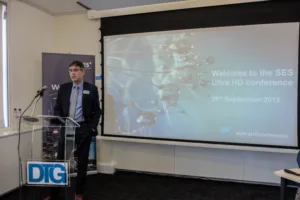SES hosted a conference in London at the end of September, providing updates on the UltraHD rollout.
Chris Forrester, journalist for outlets including Inside Satellite and Advanced Television, said that the format has taken “huge steps forward” over the last six months. UltraHD channels have been launched worldwide, and not only in mature markets. India, for example, now has access to UltraHD content.
SES is broadcasting several UltraHD channels from its 19.2° East position. The interesting point was that these channels are not from the pay-TV community; it was originally thought that pay-TV companies would drive the push to higher resolutions.
Nick Simon of GfK said, last year, 50″+ TVs represented 25% of global market value. In 2015, sales have already reached 36% of value, with three monhs of the year still remaining. Affordabilty is a driver here – set prices are falling, but more are being sold. For example, a 48″ TV now costs about £975 ($1,480). Sales of large TVs have passed 500,000 in the Q1-Q3 period. In 2017, Simon expects sales to pass 3 million.
In a panel session David Klafkowski, MD of post-production house, The Farm, said that there is now “a genuine push” to drive HDR content; the combination of large TV sizes, more pixels and better content is very compelling. In the same session Thomas Wrede of SES said that he saw a world with more than 1,000 UltraHD channels by 2025 – 225 of them in Europe. He also boasted about satellite’s efficiency, saying that two UltraHD channels can be carried on a single transponder. Closing the session Andy Quested, BBC’s head of technology, said that the broadcaster would not charge a premium for access to UltraHD services (older UK readers might remember that the BBC did this with colour TV – TA).
The first Dolby Vision TV will be launched on the 6th October (it has now been launched: see Dolby Vision Arrives With Vizio), said Ian Lowe – senior manager (EMEA) of Imaging at Dolby Labs. He said that Warner Bros and Sony will release content in the Dolby Vision HDR format, and Vudu has been confirmed as the company’s first Dolby Vision streaming partner.
Dolby Vision currently uses brightness levels up to 40 times brighter than current standards. Lowe said that as displays improve, it will be capable of delivering up to 100 times more brightness than is possible today.
UltraHD Phase 1 (which only encompasses higher resolutin) has been a limited success, said Thierry Fautier, VP of video strategy at Harmonic. Only “a handful” of countries are currently offering such services. However, this is expected to change when Phase 2 (which includes ‘better pixels’: HDR, WCG and HFR) is rolled out in 2017 and 2018. Fautier quoted data from Parks Associates, which estimates that more than 40 million US homes will take UltraHD pay-TV services by 2018.
A panel session followed, with Fautier, Wrede, Richard Lindsay-Davies (CEO of the Digital Television Group) and Eric Achtmann (co-founder of V-Nova). All agreed that more needs to be done to educate consumers about UltraHD.
Lindsay-Davies said that, as 2015 continues, the DTG will work more closely with retailers to brief them on the benefits of new displays. He added that there needs to be a “step change” for the format to be successful: a combination of various elements (such as WCG and HDR), which then need to be translated into studio workflows and distribution.
On the retail panel, members (including representatives of LG, Sony and Samsung) called for more training of shop floor sales staff selling UltraHD products. John Adam of Samsung emphasised the importance of using the Digitaleurope logo.
At the conclusion of the event, Forrester said that Freesat and SES are launching a private UltraHD demo channel together.

